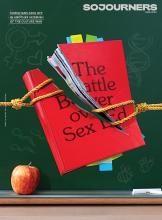parable of the sower
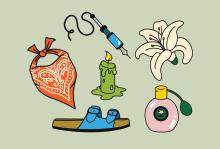
THERE'S NEVER A bad time to show a woman you value that she’s a woman of valor. But there are bad gifts. Just because your favorite Jesus feminist loves Mary Oliver, for instance, doesn’t mean you should gift her a wild goose — no matter how harsh and exciting the goose may be. Also, do not arrange a telegram delivered to her by a man dressed in a gazelle outfit reading the Song of Songs; her parents might be over for Sunday dinner! And I can’t emphasize this enough: Do not gift her an animatronic infant in a basket floating down a river. I learned that one the hard way.
But don’t worry, there are plenty of other options:
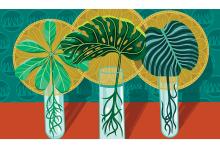
BEFORE THE PANDEMIC hit, I could have told you the precise number of my indoor plants: zero. But then lockdown started and, like countless people around the world, I became obsessed with all things leafy and green. Once I learned how to keep a plant alive, I began to nurture cuttings. To see that first fresh leaf grow — an assurance that new roots had taken hold — filled me with a kind of joy heretofore unknown.
I needed to feel like life could not just survive, but flourish and thrive. “Give this at least six weeks before repotting,” I would text a friend from her porch as I dropped off the gift of a budding leafy monstera, “just to let the roots settle.” Then I’d trudge back to the sidewalk to watch my friend open her door, wave to me, and take this small extension of myself into her home. Months later, when we could visit in person, I’d get to see how much these little ones had grown. Great leafy extensions of love.
Most of the gospel readings this month contain horticultural parables — seeds and soil, wheat and weeds, sowers and reapers. Before the COVID-19 years, I had never read these parables through the eyes of someone who had nurtured plants to life. Their images had been abstractions, ideas, metaphors with no roots. But now that those seeds have grown, I see each one anew. Perhaps you do too?
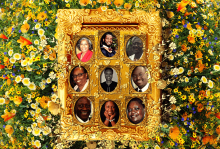
On the seventh anniversary of the martyrdom of the Mother Emanuel Nine, we still need to heed the text they were studying that evening.

ON JUNE 18, 2015, 350 leaders “committed to changing the world through faith and justice” came to Catholic University in Washington, D.C., for Sojourners’ annual gathering, The Summit. The planned sessions that day included “Criminalization of Blackness, Poverty, and Youth,” “Implicit Bias 2.0,” and “An Examination of Restorative and Transformative Justice Models.” As we gathered, we began to hear news of a horrible tragedy that had occurred the night before at Mother Emanuel AME Church in Charleston, S.C. We learned that nine church members were killed by a white supremacist during a Bible study. Our gathering became a time to hold one another in prayerful lamentation and shared grief.

IN MARCH , I made my first, and hopefully last, “panic-buy” of the pandemic: three survivalist books that look more like they belong in a nuclear bunker than on my bookshelves amid the theology, poetry, and knitting patterns. My purchases were, however, inspired by my reading Parable of the Sower and Parable of the Talents, classics by the science fiction literary giant Octavia E. Butler (1947-2006).
In these novels, Lauren Olamina—a young, disabled black girl—survives the apocalypse and helps rebuild society with her knowledge of edible wild plants, her sheer will and bravery, and her newfound religion, Earthseed. Lauren’s ability to adapt, to change, is her route through unimaginable suffering and the bedrock of her faith.
Originally published in 1993 and 1998, respectively, Butler’s Parable books were reissued last year, highlighting their current resonance. Sower introduces us to the United States in 2024, a dystopia ravaged by global warming, capitalism, and violence. Slavery, misogyny—the witch-burning kind—homelessness, and addiction are rampant. Lauren’s community is secure as long as the walls that surround it stand; as she rightly senses, walls are wont to crumble. She launches a backup plan that offers a hard hope within relentless loss. Talents continues Lauren’s, and her daughter Asha’s, journeys over the coming decades as the U.S. faces rising terrorist Christian nationalism and the election of an ultraconservative president who wants to “make America great again.”

The focus of [Jas Singh]'s farm is not production, but invitation — to allow all manner of flesh-and-blood to participate in the mysterious and divine but simple work of God’s kingdom — one where everyone who is fed, and those who typically don’t have the means to provide actually find they have an abundant harvest to share with their neighbor. It is a way to radically engage in leveling the field for all to give, receive, and partake in a way that doesn’t match our unjust economic structures.
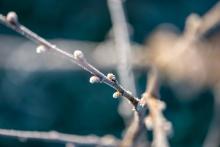
The day after Easter, it snowed. I was carrying in my last buckets of sap before leaving for Portland and was not surprised by the flurries, but they still stymied my expectations of warmer weather. The equinox had passed several weeks before, and while the start of spring had been marked on the calendar, it was (is) dragging its feet in coming.
Who has known the mind of God or even a good 7-day weather forecast?
We see and know in part. Certainty has never been the steady state of the human condition. Our lives are stretched with the awareness that clarity, at its best, comes with a smudge.
The experience of knowing we do not know can be felt in different ways. One is confusion, another, mystery. Both are confrontations of the hidden or unknown, but one brings us to awe and the other despair. One can leave us feeling isolated and the other in wonder at our relationship to that which is so much greater than ourselves.
The space between the two is not in the level of knowledge but rather our relationship to the knowing and unknowing itself. In the midst of our unknowing, we are faced with a choice: passive uncertainty or the stumbling action of faith. The beginning of wisdom is not the expectation of certainty with knowledge but the understanding that the kind of life most worth living is always an act of faith.

I love October. As a teacher, it was that time of year where rhythms were becoming established and the seeds of learning were beginning to sprout. In ministry, it is the time where I find myself riding the waves of my student’s school schedules in an effort to connect and converse. In either case, education, shapes not on the schedule of my life but the purpose.
As I breathe in the crisp autumn breeze, it reminds me to consider the larger partnership between the educators and the church. When we, as ministers and church leaders, consider what role education plays in the life of the church, we have to consider the active part of the church in the education of not only the church community, but its larger context.
Education, in the public context, is a constant topic of political struggle and strife. Education, in the ecclesial context, in its best is in-depth Bible study and at its worst is education by osmosis and observation. What is the call or consideration of the church to the topic of education? What role does the church have in the education of the community?
My favorite characters in The Lord of the Rings are the Ents -- an ancient race of giant living, talking, breathing trees in J.R.R. Tolkien's fictional land, Middle Earth. I have a little confession to make: Whenever I hear a reading from Isaiah 55 where it says, "The mountains and hills before you shall burst into song and all the trees of the field shall clap their hands," I always picture the Giant Ents from The Lord of the Rings. And then I picture these clapping trees from Isaiah holding little Hobbits in their branch arms in what ends up a willful conflation of Middle Earth and Major Prophet.
